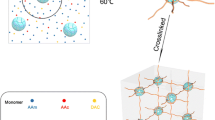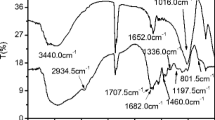Abstract
Hydrogels of different composition based on the copolymerization of N-isopropyl acrylamide and surfmers of different chemical structure were tested in elongation using Hencky/real definitions for stress, strain, and strain rate, offering a more scientific insight into the effect of deformation on the properties. In a range between \(\dot {\varepsilon }=10\) and 0.01 s\(^{-1}\), the material properties are independent of strain rate and show a very clear strain hardening with a “brittle” sudden fracture. The addition of surfmer increases the strain at break \(\varepsilon _{\mathrm {H}}^{\max }\) and at the same time leads to a failure of hyperelastic models. The samples can be stretched up to Hencky strains \(\varepsilon _{\mathrm {H}}^{\max }\) between 0.6 and 2.5, depending on the molecular structure, yielding linear Young’s moduli E\(_{0}\) between 2,700 and 39,000 Pa. The strain-rate independence indicates an ideal rubberlike behavior and fracture in a brittle-like fashion. The resulting stress at break \(\sigma _{\textrm max}\) can be correlated with \(\varepsilon _{\mathrm {H}}^{\max } \) and \(E_{0}\) as well as with the solid molar mass between the cross-linking points \(M_{\mathrm {c}}^{\textrm {solids}} \), derived from \(E_{0}\).






Similar content being viewed by others
References
Auhl D, Stange J, Münstedt H, Krause B, Voigt D, Lederer A, Lappan U, Lunkwitz K (2004) Long-chain branched polypropylenes by electron beam irradiation and their rheological properties. Macromolecules 37(25):9465–9472
Bajpai AK, Shukla SK, Bhanu S, Kankane S (2008) Responsive polymers in controlled drug delivery. Prog Polym Sci 33(11):1088–1118
Bryant SJ, Anseth KS (2002) Hydrogel properties influence ECM production by chondrocytes photoencapsulated in poly(ethylene glycol) hydrogels. J Biomed Mater Res 59(1):63–72
Burdick JA, Anseth KS (2002) Photoencapsulation of osteoblasts in injectable RGD-modified PEG hydrogels for bone tissue engineering. Biomaterials 23(22):4315–4323
Calvert P (2009) Hydrogels for soft machines. Adv Mater 21(7):743–756
Chatraei S, Macosko CW, Winter HH (1981) Lubricated squeezing flow: a new biaxial extensional rheometer. J Rheol 25(4):433–443
Ferry JD (1980) Viscoelastic properties of polymers. Wiley, New York
Friedrich T, Tieke B, Meyer M, Pyckhout-Hintzen W, Pipich V (2010a) Thermoresponsive copolymer hydrogels based on NIsopropylacrylamide and cationic surfactant monomers prepared from micellar solution and microemulsion in a one-step reaction. J Phys Chem B 114(17):5666–5677
Friedrich T, Tieke B, Stadler FJ, Bailly C, Eckert T, Richtering W (2010b) Thermoresponsive copolymer hydrogels on the basis of N-isopropylacrylamide and a non-ionic surfactant monomer: swelling behavior, transparency and rheological properties. Macromolecules 43(23):9964–9971
Friedrich T, Tieke B, Stadler FJ, Bailly C (2011a) Improvement of elasticity and strength of poly(N-isopropylacrylamide) hydrogels upon copolymerization with cationic surfmers. Soft Mater 7(14):6590–6597
Friedrich T, Tieke B, Stadler FJ, Bailly C (2011b) Copolymer hydrogels of acrylic acid and a nonionic surfmer: pH-induced switching of transparency and volume and improved mechanical stability. Langmuir 27(6):2997–3005. doi:10.1021/la104585k
Gent AN (1996) A new constitutive relation for rubber. Rubber Chem Technol 69(1):59–61
Hagiwara Y, Putra A, Kakugo A, Furukawa H, Gong JP (2010) Ligament-like tough double-network hydrogel based on bacterial cellulose. Cellulose 17(1):93–101
Hashmi S, GhavamiNejad A, Obiweluozor F, Vatankhah-Varnoosfaderani M, Stadler FJ (2012a) Supramolecular interaction controlled diffusion mechanism and improved mechanical behavior of hybrid hydrogel systems of zwitterions and CNT. Macromolecules 45(24):9804–9815. doi:10.1021/ma301366h
Hashmi S, Obiweluozor F, GhavamiNejad A, Vatankhah-Varnoosfaderani M, Stadler FJ (2012b) On-line observation of hydrogels during swelling and LCST-induced changes. Kor-Austr Rheol J 24(3):191–198
Hencky H (1928) Über die Form des Elastizitatsgesetzes bei ideal elastischen Stoffen. Z Tech Physik 9:215–220
Hern DL, Hubbell JA (1998) Incorporation of adhesion peptides into nonadhesive hydrogels useful for tissue resurfacing. J Biomed Mater Res 39(2):266–276
Hopfner J, Klein C, Wilhelm M (2010) A novel approach for the desalination of seawater by means of reusable poly(acrylic acid) hydrogels and mechanical force. Macromol Rapid Commun 31(15):1337–1342
Hu XB, Wang T, Xiong LJ, Wang CY, Liu XX, Tong Z (2010) Preferential adsorption of poly(ethylene glycol) on hectorite clay and effects on poly(N-isopropylacrylamide)/hectorite nanocomposite hydrogels. Langmuir 26(6):4233–4238
Johnson JA, Turro NJ, Koberstein JT, Mark JE (2010) Some hydrogels having novel molecular structures. Prog Polym Sci 35(3):332–337
Khalid MN, Ho L, Agnely F, Grossiord JL, Couarraze G (1999) Swelling properties and mechanical characterization of a semi-interpenetrating chitosan/polyethylene oxide network—comparison with a chitosan reference gel. Stp Pharma Sci 9(4):359–364
Kloxin AM, Kloxin CJ, Bowman CN, Anseth KS (2010) Mechanical properties of cellularly responsive hydrogels and their experimental determination. Adv Mater 22(31):3484–3494
Kopecek J (2009) Hydrogels from soft contact lenses and implants to self-assembled nanomaterials. J Polym Sci A Polym Chem 47(22):5929–5946
Kretlow JD, Klouda L, Mikos AG (2007) Injectable matrices and scaffolds for drug delivery in tissue engineering. Adv Drug Deliv Rev 59(4–5):263–273
Kuckling D (2009) Responsive hydrogel layers—from synthesis to applications. Colloid Polym Sci 287(8):881–891
Macosko CW (1994) Rheology: principles measurements and applications. Wiley, Poughkeepsie
Martin JE, Adolf D, Wilcoxon JP (1988) Viscoelasticity of near-critical gels. Phys Rev Lett 61(22):2620–2623
Mooney M (1940) A theory of large elastic deformation. J Appl Phys 11(9):582–592
Nie T, Baldwin A, Yamaguchi N, Kiick KL (2007) Production of heparin-functionalized hydrogels for the development of responsive and controlled growth factor delivery systems. J Control Release 122(3):287–296
Nishioka A, Takagi Y, Takahashi T, Masubuchi Y, Takimoto J, Koyama K (1998) Measurement of biaxial elongational viscosity of polymer melts using lubricated squeezing flow method. J Soc Mater Sci Jpn 47(12):1296–1300
Rivlin RS (1948) Large elastic deformations of isotropic materials. IV. Further developments of the general theory. Philos Trans R Soc Lond Ser A, Math Phys Sci 241(835):379–397
Sawhney AS, Pathak CP, Hubbell JA (1993) Bioerodible hydrogels based on photopolymerized poly(ethylene glycol)-co-poly(alpha-hydroxy acid) diacrylate macromers. Macromolecules 26(4):581–587
Schexnailder P, Schmidt G (2009) Nanocomposite polymer hydrogels. Colloid Polym Sci 287(1):1–11
Schmaljohann D (2006) Thermo- and pH-responsive polymers in drug delivery. Adv Drug Deliv Rev 58(15):1655–1670
Sentmanat ML (2004) Miniature universal testing platform: from extensional melt rheology to solid-state deformation behavior. Rheol Acta 43(6):657–669
Stadler FJ, Nishioka A, Stange J, Koyama K, Münstedt H (2007) Comparison of the elongational behavior of various polyolefins in uniaxial and equibiaxial flows. Rheol Acta 46(7):1003–1012
Stadler FJ, Kaschta J, Münstedt H, Becker F, Buback M (2009) Influence of molar mass distribution and long-chain branching on strain hardening of low density polyethylene. Rheol Acta 48(5):479–490
Stange J, Uhl C, Münstedt H (2005) Rheological behavior of blends from a linear and a long-chain branched polypropylene. J Rheol 49(5):1059
Trouton FT (1906) On the viscous traction and its relation to that of viscosity. Proc R Soc 77:426
Veerman C, Rajagopal K, Palla CS, Pochan DJ, Schneider JP, Furst EM (2006) Gelation kinetics of beta-hairpin peptide hydrogel networks. Macromolecules 39(19):6608–6614
Winter HH, Chambon F (1986) Analysis of linear viscoelasticity of a cross-linking polymer at the gel point. J Rheol 30(2):367–382
Xu CY, Breedveld V, Kopecek J (2005) Reversible hydrogels from self-assembling genetically engineered protein block copolymers. Biomacromolecules 6(3):1739–1749
Yamaguchi N, Kiick KL (2005) Polysaccharide-poly(ethylene glycol) star copolymer as a scaffold for the production of bioactive hydrogels. Biomacromolecules 6(4):1921–1930
Yang JY, Xu CY, Kopeckova P, Kopecek J (2006a) Hybrid hydrogels self-assembled from HPMA copolymers containing peptide grafts. Macromol Biosci 6(3):201–209
Yang JY, Xu CY, Wang C, Kopecek J (2006b) Refolding hydrogels self-assembled from N-(2-hydroxypropyl)methacrylamide graft copolymers by antiparallel coiled-coil formation. Biomacromolecules 7(4):1187–1195
Yu K, Marin JMR, Rasmussen HK, Hassager O (2010) 3D modeling of dual wind-up extensional rheometers. J Non-Newton Fluid Mech 165(1–2):14–23
Acknowledgments
The authors want to acknowledge the financial aid from the Communauté Française de Belgique, Deutsche Forschungsgemeinschaft priority program 1259 “Intelligent Hydrogels” (project number TI219/10-3), the National Research Foundation of Korea, and the “Human Resource Development (Advanced track for Si-based solar cell materials and devices, project number 201040100660)” of the Korea Institute of Energy Technology Evaluation and Planning grant funded by the Korean government Ministry of Knowledge Economy.
Author information
Authors and Affiliations
Corresponding authors
Additional information
Special issue devoted to novel trends in rheology.
Rights and permissions
About this article
Cite this article
Stadler, F.J., Friedrich, T., Kraus, K. et al. Elongational rheology of NIPAM-based hydrogels. Rheol Acta 52, 413–423 (2013). https://doi.org/10.1007/s00397-013-0690-x
Received:
Revised:
Accepted:
Published:
Issue Date:
DOI: https://doi.org/10.1007/s00397-013-0690-x




